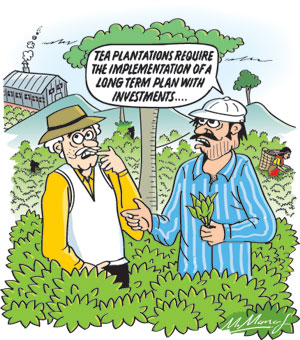Columns
Higher tea production vital for enhancing exports and improving trade balance
View(s):Increasing tea production and exports is vital for improving the country’s exports and trade balance. Reversing the declining trend in tea production with a long-term investment plan is imperative to achieve this.
Tea production
Last year’s tea production of only 260 million kilograms was the lowest since 1994. It was a decrease of 34 million kg from 294 million kg in 2022. It was one of the lowest tea outputs in the history of tea in Sri Lanka. Consequently, tea exports brought in only US$ 1.1 billion compared to average export earnings of about US$ 1.3 billion.
Declining trend
This declining trend in production and exports of tea has to be reversed to improve the country’s trade balance. Last year’s trade deficit, which widened to US$ 4.9 billion, could be narrowed by increased tea exports. It is the inadequate production of tea that reduces the exportable quantity.
Market for tea
Although the country’s tea exports are decreasing, the international market for Sri Lankan tea is quite robust. The recent oil-for-tea agreement with Iran has also boosted the country’s tea export potential.
Declining production
The plantation sector’s tea production has been on a decreasing trend since independence. The declining trend in tea production over time is due to a number of reasons. Only a long-term investment in tea can revive the industry to its full potential.
Early causes
The high rates of taxation in the 1950s and 1960s, the threat of nationalisation in the 1960s and 1970s that materialised in 1974, and the mismanagement of tea estates by state corporations were, among others, underlying reasons for decreased production.
No investment
Consequently, the plantations did not invest adequately to maintain and enhance production.
A large extent of the plantations has senile tea bushes and vacancies. There has been a woeful lack of replanting and infilling with high-yielding Vegetatively Propagated Teas (VPP).
Fertiliser fiasco
The continuing decline in tea production recently is attributed to the banning of chemical fertilisers and pesticides in 2020. Now there is a rebound in tea production, though not a full recovery.
Imperative
The decline in tea production can only be reversed by a long-term plan that invests in these improvements.
Smallholdings
In contrast, tea production increased on smallholdings, mainly in the South. The virgin soils, VPP teas, and longer periods of sunlight are among the reasons for the higher productivity of the smallholdings. Yields are about twice the productivity on the estates.
Consequently, nearly 80 percent of the country’s tea is produced on smallholdings. Their problems, too, need to be addressed promptly.
Problems
The unavailability of chemical fertiliser and weedicides, fuel for the transport of smallholder tea leaves, and financial constraints have been responsible for this dip in production and exports. Immediate steps must be taken to restore tea production and exports.
Peak production
Tea production reached a peak of 310 kg in 1990. Last year’s tea production fell to only 260 million kg, a drop from 294 million kg in 2022.
Reverse trend
This trend of low tea production on estates must be reversed to enhance the country’s export earnings. A long-term strategy and higher investments are needed to achieve it. The chemical fertiliser and pesticide issues, which contributed to the continuing decline in tea production, are being resolved.
Recovery
Nevertheless, tea production is struggling to recover after the monumental folly of banning chemical fertiliser and pesticides in 2020.
The tea industry expects a bigger crop this year if there is adequate rainfall. There is a rebound in tea production, though not a full recovery.
Investment
Declining tea production that has reduced export earnings must be reversed by a development programme.
Smallholders
The high costs of chemical fertiliser and weedicides, fuel for the transport of smallholder tea leaves to factories, and financial constraints have been responsible for this dip in production and exports. Immediate steps must be taken to restore tea production and exports.
Longer view
The thrust of this discussion is that an increase in tea production is important for the country’s foreign exchange earnings. This requires long-term vision, planning, and investments.
The current conditions in the country are hardly conducive to such a vision. The tea industry and stakeholders must make the next government realise the importance of a long-term plan for tea production. The mere revival from the fertiliser blunder is inadequate.
Conclusion
The declining trend in tea production has resulted in lower export earnings. Increasing the productivity of the estates over the long term will strengthen the balance of trade, reduce the trade deficit and improve the balance of payments.
A long-term development programme with adequate funding and incentives is needed to achieve this. Will the next government be able to achieve this?
Buying or selling electronics has never been easier with the help of Hitad.lk! We, at Hitad.lk, hear your needs and endeavour to provide you with the perfect listings of electronics; because we have listings for nearly anything! Search for your favourite electronic items for sale on Hitad.lk today!


Leave a Reply
Post Comment